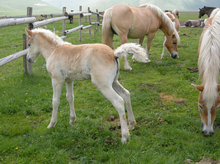Pastures can be a rich source of nutrients for your horse. As most horse owners know, quality forage, whether it is hay or pasture, should be the foundation of any horse's feeding program. Good quality pasture can provide much of the nutrition a horse needs.

Pasture = Economical feed for horses
Pastures can be a rich source of nutrients for your horse, and as most horse owners know, quality forage, whether it is hay or pasture, should be the foundation of any horse's feeding program.
Another important fact about pastures is that they also provide an economical source of forage. The cost of pasture as a feed is estimated to be about one-tenth the cost of hay.
The ability of pasture to supply the feed requirements of your horse will depend on several factors:
- Species growing in the pasture - Legumes are higher in protein and digestible energy (calories) and lower in fibre than grasses. Therefore, a pasture with a higher proportion of legumes, such as alfalfa or clover, will possess a higher nutritional value compared to an all-grass pasture.
- Plant's stage of maturity - Pasture forages are high in nutritional value when actively growing and become lower in nutritional value with maturity. The more immature the plant, the more nutritious and palatable; however, the smaller the plant, the less feed it provides.
- Season - Spring grass contains the highest levels of protein and lowest levels of fibre of any grass of the year. As the grazing season progresses into summer and fall, a reduction in growth and an increase in maturity of the forage leads to a lower nutritional value.
- Horse's physiological state - In many cases, good quality pasture can meet the nutritional needs of most adult pleasure horses, along with water, salt and trace mineral supplementation. Even growing two-year olds can get all they need from good quality pasture. Weanlings, yearlings, pregnant and lactating mares and horses in hard work, however, may be left short by an all-pasture diet. These groups of horses have higher nutritional requirements and would likely require grain feeding as well as grazing.
Taking representative samples of the forage growing in your pasture at different times of the year and sending them to a laboratory for chemical analyses is the most accurate way to help you determine the overall feeding value of your pasture.
How much pasture is your horse eating?
In addition to knowing the feeding value of the forage in your pasture, you should pay attention to how forage the horse is eating.
Pasture intake will vary depending on the season, species and quality of pasture grazed, length of grazing time and grazing management.
In addition to what your horse consumes, you must also account for how much forage your horse damages through trampling. One rule of thumb is that a horse will eat, trample or damage 1 pound of forage per pound of body weight per month. Therefore, to sustain an average 1,100 lb horse, a pasture must be capable of producing at least 1,100 lbs of forage each month. With proper grazing management, the amount of forage needed per horse can be reduced by 10 to 20 per cent.
The amount of forage a pasture produces varies by the type of forage growing and the season. Grass and grass-legume pastures produce more forage over the grazing season than pastures consisting of native rangeland species. Growth is most abundant in the spring and early summer, while growth slows in the summer and fall.
